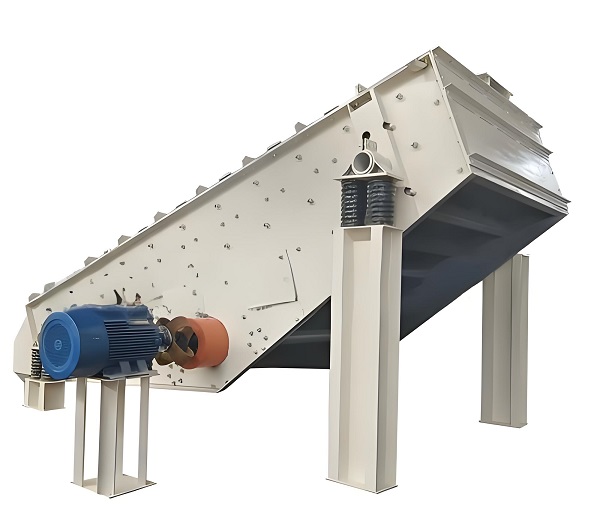
Finger screens, also known as finger grids or grid decks, are specifically designed for use in waste disposal, recycling, topsoil, compost, and gravel industries. The absence of cross-wires eliminates clogging and material catch, while the cascade effect produced by the poly-block fingers provides effective screening in demanding applications.
Finger Screens are mainly used in industries such as garbage sorting, metallurgy, coke, coal, coal washing, chemical engineering, building materials and hydropower engineering, abrasive waste treatment, and quarrying for material washing, screening, and grading. A new structural pattern sieve plate with various sizes and mesh sizes of rod vibrating screens, especially suitable for applications with strong impact, high hardness, and high wear resistance requirements.
Finger Screens is used for fine screening of iron ore, classification of raw coal, screening of gold, building materials, as well as sand and gravel in hydropower and nuclear power projects with wear-resistant screen plates. The Finger Screens machine equipment is a door type Finger Screens used for the treatment of stale household waste, including door type bars, bar card slots, vibration frames, vibrators, slide plates, discharge ports, and guide slots; The door shaped bar is a whole structure consisting of two bar supports and bar beams, with the bar beams serving as the material screening surface; The vibration frame is a rectangular frame, tilted and equipped with baffles on both sides that are higher than the screening surface of the bar; There are several sets of rod slots on the vibration frame, and the rod supports are fixed on the rod slots to form a whole door shaped rod screen frame; The height of the bar sieve support is 40-100cm; The higher end of the door shaped bar screen is the feeding area, which is equipped with an inclined chute plate. The chute plate is disposed of above the screen surface; There is a discharge port below the vibration frame, and a guide groove is located at the bottom of the discharge port. The gate shaped bar in this design is a rectangular gate shaped whole with a wide cross-section, high strength, and the ability to make a longer screen surface
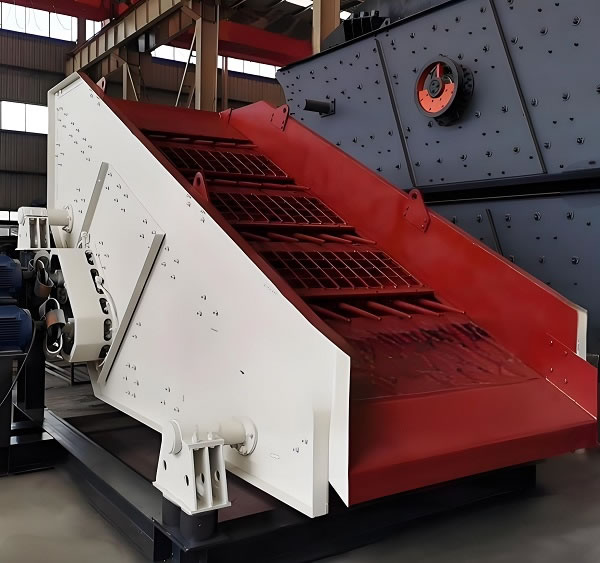
When choosing a Finger Screens multiple factors need to be considered to ensure that it can meet specific screening requirements and production environments. Here are some key selection points:
1.Particle size and shape: Understand the particle size distribution and shape of the material to be screened, in order to determine the required sieve hole size and sieve surface form. Rod sieve is suitable for screening coarse materials, such as large ores, construction waste, etc.
2.Humidity and viscosity: For materials with high humidity and high viscosity, it is necessary to choose a bar sieve with self-cleaning function to reduce clogging.
3.Processing capacity: Based on the processing capacity of the production line, select the corresponding specifications and models of bar screens to ensure that screening efficiency matches production needs.
4.Replacement of vulnerable parts: Consider the convenience of replacing vulnerable parts such as screen surfaces and vibrators to reduce maintenance costs and improve equipment utilization.
When selecting a Finger Screens, it is necessary to comprehensively consider multiple aspects such as material characteristics, production capacity requirements, equipment performance and structure, maintenance and upkeep, as well as supplier and after-sales service. By carefully comparing and evaluating bar screens of different brands and models, the most suitable equipment for one's production needs can be selected
The bearings of Finger Screens are sturdy, have a long service life, and operate stably and reliably.
Complete sets or single rolls up to a maximum 1600 mm wide as well as strong construction. 810 mm x 32 mm forged tines individually replaceable tampered bushes also supplied. Optional angle adjustment available if required.
The design is more mature and complete, with strong excitation force, high screening efficiency, low noise, and economical use. Rod screens come in two structural forms: open and closed, suitable for different operating environment requirements. The screen surface has single-layer and multi-layer structural forms, and the operating trajectory has multiple models and specifications, including straight and circular forms. Easy installation and debugging, stable and reliable operation, and easy operation and maintenance.
The Finger Screens has a simple and compact structure, beautiful appearance, and high overall rigidity and strength of each part; Relatively small in size and light in weight, convenient for system process layout. Rod sieve has a relatively large processing capacity, low energy consumption, and is not easily clogged. Rod sieve is particularly suitable for screening materials with high moisture content and high viscosity.
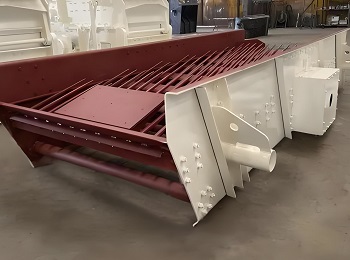
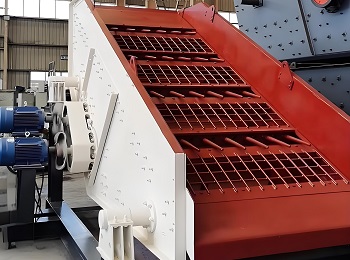
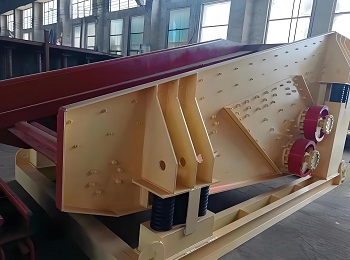
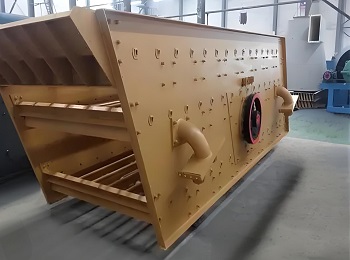
When the Finger Screens is working, the excitation force generated by the exciter is transmitted to the screen surface inside the screen box through the screen box. As the excitation force generated by the exciter is longitudinal force, it forces the screen box to drive the screen surface to undergo longitudinal forward and backward displacement. Under certain conditions, the material on the sieve surface of the rod vibrating screen is thrown forward by the excitation force. When the material falls below the sieve hole, it passes through the screen and falls to the lower layer. The motion trajectory of the material on the sieve surface of the rod vibrating screen is a parabolic motion. The rod vibrating screen completes the material screening operation by repeating the material motion due to this circumference.
The Finger Screens is mainly composed of a vibrating frame, springs, vibrators, motor vibrating frames, and motors. The exciter is composed of two eccentric shafts at specific positions that mesh with gears. During assembly, the two gears must mesh with each other according to the markings, and the two eccentric shafts are driven by a motor to rotate, thereby generating a huge synthesized linear excitation force. The machine body is forced to vibrate on the supporting spring, and the material is driven by this vibration to slide and throw on the material trough. When the material passes through the sieve bar on the trough, smaller materials can fall through the gap between the sieve bars without going through the next crushing process, which has the effect of screening and improves work efficiency.

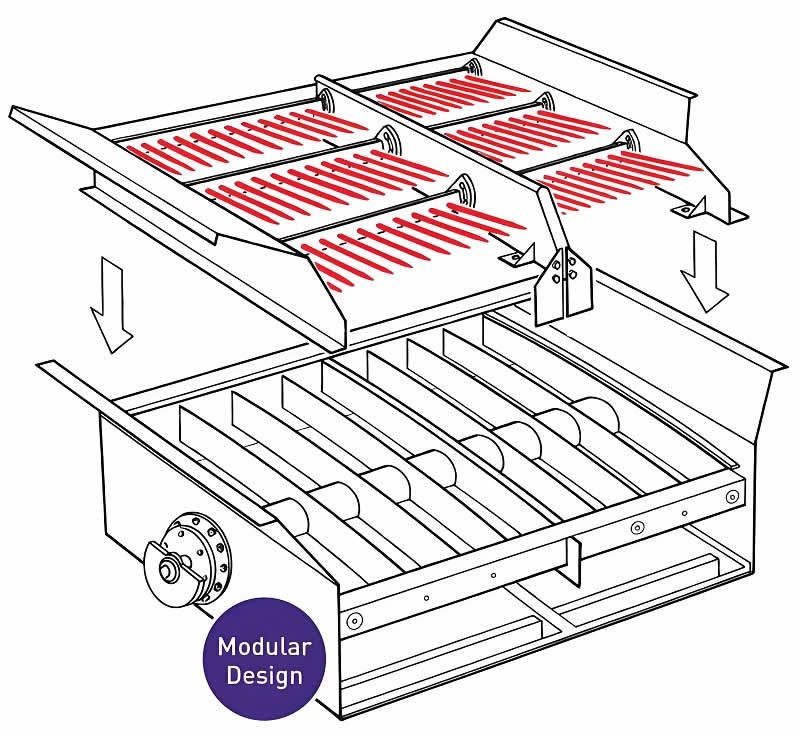
| Equipment model | Layers | Tilt angle range (°) | Reference power (kw) | Mesh range (mm) | Processing capacity (t/h) | Best Feed (cm) |
| TS-1200 | 2-3 | 18-25 | 5.5-11 | 3-50 | 20-120 | ≤30 |
| TS-1500 | 2-4 | 18-25 | 7.5-15 | 3-60 | 30-150 | ≤35 |
| TS-1800 | 2-4 | 18-25 | 11-22 | 3-70 | 40-280 | ≤40 |
| TS-2100 | 2-3 | 18-25 | 15-30 | 3-80 | 50-350 | ≤30 |
| TS-2400 | 2-3 | 20-25 | 22-37 | 3-100 | 60-500 | ≤30 |
*The output will vary according to different materials, feed particle size and other factors.
Save Time! Get A Detailed Quotation Quickly.
